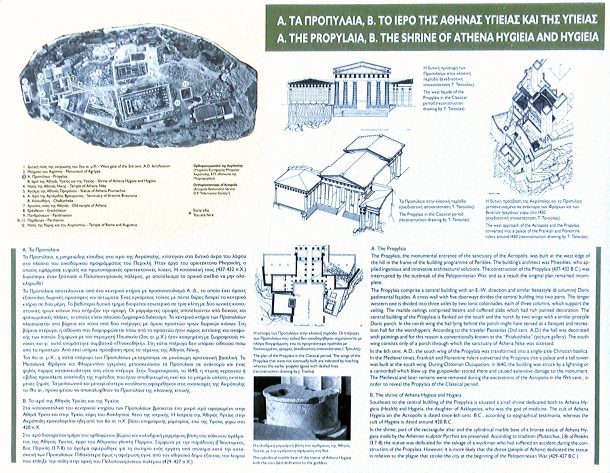The Propylaia, the monumental entrance of the sanctuary of the Acropolis, was built at the west edge of the hill in the frame of the building programme of Perikles. The building’s architect was Mnesikles, who applied ingenious and innovative architectural solutions. The construction of the Propylaia (437-432 B.C.) was interrupted by the outbreak of the Peloponnesian War, and as a result the original plan remained incomplete.
The Propylaia comprise a central building with an E.-W. direction and similar hexastyle (6 columns) Doric pedimental facadet. A cross-wall with five doorways divides the central building into two parts. The longer western one is divided into three aisles by two Ionic colonnades, each of three columns, which support the ceiling. The marble ceilings comprised beams and coffered slabs which had rich painted decoration. The central building of the Propylaia is flanked on the south and the north by two wings with a similar prostyle Doric porch. In the north wing the hall lying behind the porch might have served as a banquet and recreation hall for the worshippers. According to the traveler Pausanias (2nd cent. A. D.) the hall was decorated with paintings and for this reason is conventinally known as the “Pinakotheke” (picture gallery). The southwing consists only of a porch through which the sanctuary of Athena Nike was accessed.
In the 6th cent. A.D., the south wing of the Propylaia was transformed into a single-aisle Christian basilica. In the Medieval times, Frankish and FIorentine rulers converted the Propylaia into a Palace and a tall tower was built at the south wing. During Ottoman Occupation, in 1640. The building was struck by a lightning or a cannonball which blew up the gunpowder stored there and caused extensive damage to the monument.The Medieval and later remains were removed during the excavations of the Acropolis in the 19th cent.in order to reveal the Propylaia of the Classical period.
A. プロピレア
プロピレアは、アクロポリス聖域の記念碑門を示し、丘の西端にあり、枠組みはペリクレスによる建築設計だった。建築家はムニシクルスで、独創的かつ革新的な建築法を使っている。 プロピレアの建設(前437-432年)はペロポネソス戦争の発生で中断、その結果、元の計画は不完全なままである。
プロピレアは東西に向いた中央の建物で、同じく玄関は6柱(6列)、正面にはドリス式ペディメント(三角形の切妻壁)がある。 5つの出入口がある横断壁は、中央の建物を2つに分割する。比較的長い西側のものは、通路3つと、イオニア式の列柱2つに分かれ、列柱はそれぞれ円柱3つで天井を支える。大理石の天井には、梁と石板が含み、豊かな装飾があった。プロピレアの中央の建物は、南翼と北翼で同様のドリス式前柱廊ポーチが側面に並ぶ。北翼ではポーチの後ろの集会場は、崇拝者たちの宴会とレクリエーション集会場として役立ったと思える。旅行者パウサニアス(2世紀)によると、この集会場は絵画で飾られていたため、この理由から、 慣習的に”ピナコテーケー”(絵画館)として知られている。南翼はポーチだけから構成し、アテナ・ナイキの聖域がある。
6世紀で、プロピレアの南翼は、単一通路のキリスト教のバシリカに変形された。中世の時代には、フランク人とフィオレンティンの支配者たちはプロピュライアを宮殿に改造し、南翼には高塔が建設された。オスマン帝国時代の1640年に、建物には稲妻か砲弾の爆破があり、そこにあった貯蔵庫の火薬は爆発し、プロピレアに大きな被害をもたらした。古典時代のプロピレアを明らかにするために、中世以降の遺跡は、19世紀にアクロポリスの発掘中に除去している。
B. アテナ・ニケとヒュギエイアの神殿
プロピレアの中央建物の東南部では小さな神殿があり、アテナ・ニケ(健康)とヒュギエイア両者の神であるアスクレピオスの娘に捧げられている。この娘は薬の神である。 アクロポリスにあるアテナ・ニケの信仰は碑文的証言によると前6世紀からのもので、ヒュギエイアの信仰は前420年である。
神殿には、長方形の祭壇の一部と、アテネの彫刻家ピロスが作ったアテネ・ニケの銅彫像のうち円筒状の大理石の土台が保存されている。伝統によれば(プルタルコス『ペリクレスの一生』、 13.7-8)、この像は、プロピレアの建設中に事故を起こした労働者の救助のために捧げられたという。 しかし、アテネの人々(demo)が、ペロポネソス戦争(前429-427年)の始まりに都市を襲う疫病と関連して捧げられたとの見解がいいだろう。
